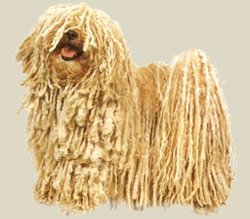
Country of Origin: Hungary
Group: Sheepdogs and Cattle Dogs (except Swiss Cattle Dogs)
Section: Sheepdogs
Original Function: sheep herding
Todays Function: herding trials
Dimension Male: 41-46 cm
Dimension Female: 36-41 cm
Weight Male: 11-16 kg
Weight Female: 9-14 kg
Litter Size: 1-3 puppies
Life span: 12-16 years
Other Names: Hungarian Puli, Hungarian Water Dog
Colors: The original puli was a multi-colored breed but today black is considered the predominate color. you
Living: One of the benefits to the puli is that the breed can do well in many different circumstances. the p
Recognized: CKC, FCI, AKC, UKC, KCGB, CKC, ANKC, NKC, NZKC, APRI, ACR
Description
The Puli (Pulik plural) is an ancient breed of Hungarian sheep dog, medium-sized, sturdy with a unique, corded coat. A full adult coat can reach to the ground. Some colors are not permitted in some countries but, in the U.K., black, any shade of gray, apricot (with or without a black mask) and the rarer white are all permissible. Their body shape is square and, though fine-boned, fairly muscular. The head from the side should be egg-shaped while from the front it will give a rounded appearance. The tail should curl fairly tightly over the back. Eyes are almond-shaped, dark brown in color, ears are medium-sized, pigment should be black.
Temperament
A mop on springs, the puli is full of bouncing energy. It is busy and curious and needs daily exercise. This smart dog is also headstrong and tough. It can be aggressive toward other dogs. Alert and watchful, it is also protective of its family. It barks a lot.
Excercise
This is an energetic breed on the lookout for a job, preferably something to herd. It can be satisfied with a good walk or jog, or a lively game and training session, however. It can live outdoors in temperate to cool climates, but it also makes an excellent house dog. Its coat can hold debris. Its nonshedding coat can be brushed or corded; if brushed, it needs brushing every one to two days. If corded, the cords must be regularly separated because the coat tends to hold dirt; bathing is time consuming and drying takes as much as one day. Pets can be clipped, but then part of the breed"s unique appeal is lost.
Grooming
The corded coat begins to form around the age of 6 months when the soft woolly undercoat intermingles with the harsher outer-coat. The mats thus formed should be separated by hand very regularly at this stage. The clumps should be torn apart by hand from
Health
Major concerns: CHD
Minor concerns: none
Occasionally seen: PRA
Suggested tests: hip, eye

